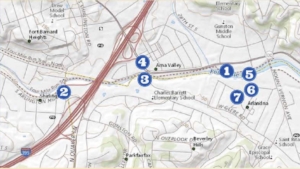Mills
From the time of colonial settlement, Four Mile Run was the power source for milling grains, especially wheat, from farmlands around Alexandria. The earliest mills were country (or custom) mills, where the miller was paid a toll, a portion of the grain being milled. Later mills were merchant mills, where the miller bought grain and produced flour for export. Merchant mills might run one set of fine French burr stones to make export quality flour and another pair of coarser stones to make cornmeal or non-export flour. By the mid- 1800s the development of steam power meant that larger mills could be built anywhere, while the smaller water-powered mills fell into disuse and disrepair. As Four Mile Run·s watershed has become more and more urban, the traces of the old mills have disappeared. Arlington Mill at Columbia Pike was the last, and it burned down a century ago.

Early Grist Mills
1. Chubb’s Mill pre-1719*
Located four poles (66 feet) below the confluence of Lower Long Branch Creek and Four Mile Run, the first mill was that of Edward Chubb, a tenant of Robert Alexander. Chubb married the widow of the miller Lilliard, who had built it prior to 1719. By the 1750’s, surveyor John West noted that only the mill’s corner posts remained.
2. Masterson’s Mill 1745*
The millwright Edward Masterson leased 300 acres of land on Four Mile Run in 1745, building a mill several hundred feet upstream of ‘two poplars’ that had been a point of reference for surveys (near Jennie Dean Park in Shirlington on Four Mile Run). Masterson died in 1754, and his will specified that a pair of millstones lying in a pasture were to be sold to pay off his debts.
Ball’s Mill 1754
The mill was built in 1754 by John Colville on the site where Lubber Run intersects Four Mile Run.
Merchant Mills
3. Carlyle’s Mill 1762-3
Alexandria’s John Carlyle owned a large estate called ‘Torthorwald’ encompassing much of present-day Fairlington and Parkfairfax. Carlyle built a mill there in 1762/3, and milled flour for export in partnership with merchant and ship-owner Robert Adam. Before building his own grist mill at Mount Vernon, George Washington had a seven-year contract to sell all his wheat to Carlyle and Adam to be milled at Four Mile Run.
4 & 5. Adam’s Mills 1763 & 1772-3*
Robert Adam built a mill opposite Carlyle in 1763 on land he leased from Charles Alexander, a short distance upstream of the present-day West Glebe Road bridge. After the partnership with Carlyle dissolved, he built a mill downstream on additional land leased from Charles Alexander. That mill, on the Alexandria-Georgetown Road, later was part of the Columbian Factory property.
Late Era Mills
Custis Mill (renamed Arlington Mill)
The mill was located on Four Mile Run at the intersection of the W&OD Trail and Columbia Pike. The mill was destroyed during the Civil War but was rebuilt in 1880. The mill dam and mill race served as an ice plant on Columbia Pike. The mill ceased operations in 1906.
6. The Janney/Drinker Mill 1806*
Robert Adam built a mill opposite Carlyle in 1763 on land he leased from Charles Alexander, a short distance upstream of the present-day West Glebe Road bridge. After the partnership with Carlyle dissolved, he built a mill downstream on additional land leased from Charles Alexander. That mill, on the Alexandria-Georgetown Road, later was part of the Columbian Factory property.
7. The Columbian Factory 1813*
Janney and Drinker were two of the founders of the Columbian Factory Company, which formed in 1813 to build and operate a water-powered cotton mill, producing yarn, some of which was sold at Janney”s store in Alexandria. Although the factory’s 1,200 spindles sounded impressive, the three-story mill was small by cotton-mill standards, and it wasn’t a success. By the time then-owner Richard B. Alexander pitched it in 1838 as a potential site for a national armaments foundry, the mill and outbuildings were in disrepair.
Roach’s Mills
The mills were located where Roach Run joins Four Mile Run. The mill was built in the early 19th century. There was a cotton mill adjacent to the grist mill.
The Arlington Mill
The mill was located where Columbia Pike intersects Four Mile Run and was built in 1836. The mill had an overshot water wheel. During the Civil War the mill suffered severe damage. The mill burned in 1920.
Barcroft Mill
The mill was located below the dam of Lake Barcroft, on the east side of Holmes Run, south of Columbia Pike. Deeds dating back to the 1700’s refer to this property as “Adams Mill Lot”. This mill was probably built by a man named Douglass. It was built on the site of an earlier mill around 1810. It is believed that Douglass had built a grist mill and a cotton mill.
*Adapted from a tri-fold brochure: “Water Mills of Four Mile Run” by Kurt Moser
Share this post